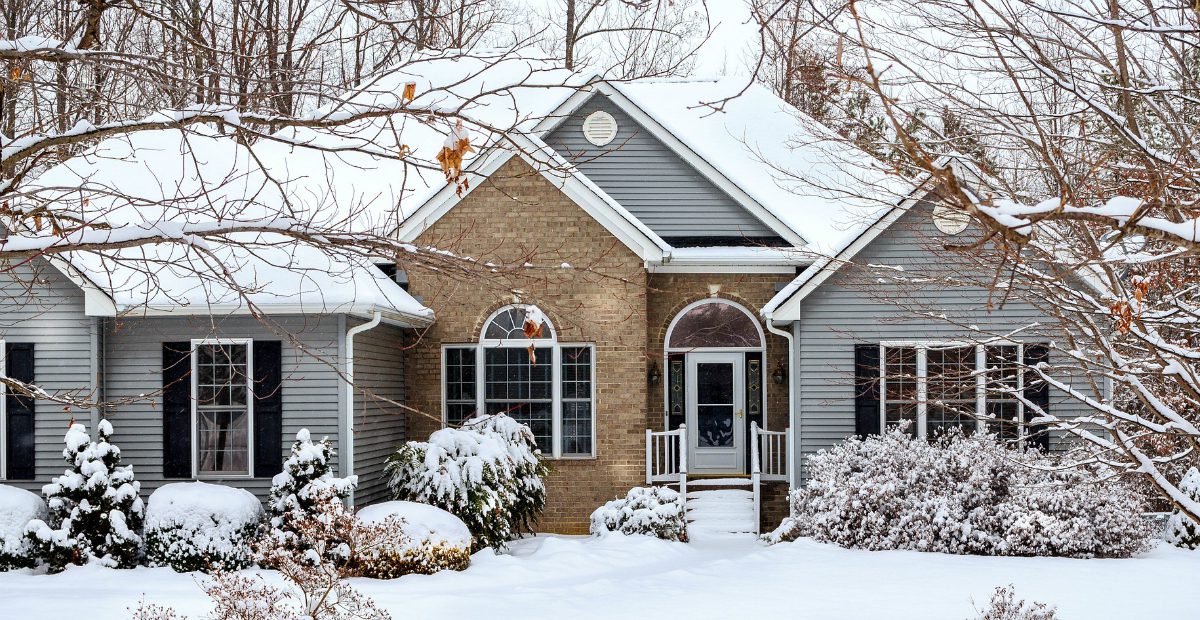For many Canadians, winter is their favourite time of the year because of all the skiing, ice skating and holiday cheer! However, it’s also the worst time of the year for your house. The cold, snow and condensation make your home susceptible to damage. They are not only expensive to repair but can be a danger to your family. Many waterproofing companies and repair contractors across the GTA receive countless calls throughout the winter, often regarding issues that could have been easily prevented with proactive measures.
One of the most common types of damage that waterproofing and water restoration services professionals see is wet or flooded basements during the winter caused by cracks in the wall, broken pipes or sump pump leakage. However, the solution is straight forward, you must winterize both the exterior and interior of your home, including the basement. Preventative measures for the exterior include clearing your gutter, keeping plants and debris away from external walls, trimming branches and turning off exterior water sources like your hose. For your home’s interior, install a carbon monoxide detector, clean your fireplace and chimney, and seal all windows. Basement maintenance comes with an extensive list, but replacing basement windows, installing flood and moisture alarms and waterproofing are the most important.
1. HOW TO WINTERIZE THE EXTERIOR OF THE HOME
Clear Your Gutters
As fall passes, your gutters become filled with leaves and branches. Properly clean your gutters so water can flow smoothly out the downspout. Check that the downspout is funnelling water away from your home and towards a storm drain so that water does not pool around your foundation. To make your job easier, you may want to clear your gutters more than once. If you are not physically able, you can also hire cleaners, or install a screen over the gutter and cover inserts. Clearing your gutter can be dangerous because of the risk of falling, so have someone hold the ladder for you and wear non-slip shoes.
If you do not: A clogged gutter can lead to high repair costs. During the winter, water can accumulate, freeze and crack the gutter. Even if it does not freeze, water can still accumulate and pour over the gutter. The water can then seep through the microcracks in your roof and foundation. If not addressed, it could cause water damage to your walls and lead to the formation of mould. In severe cases, flooding can occur.
Keep Your External Walls Clear
The external walls of your home are constantly subjected to the elements, regardless of weather conditions. In the winter, snow, ice and sunlight cause your walls to go through a cycle of freezing, thawing and drying. That’s why once spring arrives, be careful not to leave anything lying around in direct contact with your walls.
If you do not: When your walls are in contact with objects, the drying process will be delayed. If there are cracks present on the outside of your home, damp walls will only worsen the problem.
Trim the Branches
Trees can become a hazard in the wintertime. That’s why in the fall, you must trim branches that have the potential to fall and damage your home, cars, and pedestrians. Ensure these branches do not cover the exhausts in your home such as the dryer vent or chimney chute. This is because strong winter winds can weaken branches and even the roots of trees. However, pruning will rid your tree of dangerous branches and strengthen its roots. Also, placing mulch around the base of a tree will keep it healthy. Lastly, be sure to check trees throughout the winter for dead branches and weakened roots.
If you do not: Branches that are alive are still prone to breaking when ice and snow accumulate on them. These branches pose a danger to you and your family if not addressed. Not to mention possible damage to your roof, siding, gutters, porch railings, decks, and car. There are even cases of whole trees falling because of the added weight of snow and ice, in addition to weakened roots.
Turn Off Exterior Water Lines
Winter can cause several issues for water lines. That’s why you should start by disconnecting your garden hose and storing it. Also, be sure to manually shut off your home’s exterior water line. If you have a sprinkler system, shut that off as well. Then, turn both lines on to drain the remaining water and release pressure. To be extra cautious, have a contractor blow out any water that may remain in your underground lines or pipes.
If you do not: Exterior water lines are extremely vulnerable to freezing temperatures, and if not protected, it can lead to a flood. Sprinkler systems can be damaged too and are expensive to repair. If lines underneath your garden burst, you have to uproot the ground to replace it. Furthermore, the water that leaks out has the potential to flood your basement and damage the home’s foundation.
2. HOW TO WINTERIZE THE INTERIOR OF THE HOME
Protect Against Carbon Monoxide Poisoning
The odourless, colourless killer carbon monoxide (CO) poses a significant danger to homeowners. In fact, the Centers for Disease Control says at least 15,000 people are admitted to hospitals every year in the US due to CO poisoning. The risk of CO poisoning is elevated in winter because of the potential of leaks from gas furnaces, cars, propane stoves, and generators, due to the increased demand for heating. In the fall, have a technician inspect any large or small appliances that are potential sources of CO. For homes with a garage, do not warm up your car inside of it and ensure the garage has proper ventilation. Place battery-operated CO detectors throughout your home, especially in rooms where appliances could leak. Also, be sure the detectors are loud enough to hear from any room in the house.
If you do not: CO poisoning can lead to death. However, just a short exposure to CO can lead to irreversible brain damage. Because symptoms can be confused with common ailments such as dizziness and headaches, CO can poison you without you being aware. The CDC notes that most CO poisoning cases occur in January and December, so you must install a detector.
Prepare your Fireplace
For many, cozying up to a fireplace with a hot chocolate is the perfect escape from the cloudy days and frigid temperatures of winter. However, some measures should be taken in the fall, like sweeping out the fireplace once a year. Check the flue first with a flashlight to determine the amount of creosote that has accumulated. Then buy a chimney cleaning kit, if you have not already done so.
If you do not: Creosote that accumulates in your chimney can spark a fire in the flue. These flames burn inside your chimney and will erode it over time. In the worst-case scenario, embers can land on the roof’s shingles and cause your home to catch fire. Chimney fires can also cause structural damage that cannot be seen until your home starts to deteriorate.
How to Seal Your Home Properly
Winterizing your home is not always easy, because as people try to make their homes more energy efficient, they also decrease the airflow in the home by sealing off rooms and windows. Before winter hits, you must inspect the insulation throughout your home and undertake any necessary repairs. One sign that work needs to be done is the formation of ice dams on the gutters. This is caused by the top of the roof being warmer than the rest of the surface, which causes ice to melt at the top and then refreeze at the bottom. To ensure the constant flow of air, use fans and replace the filters in your HVAC system. It’s also recommended to open a few windows throughout the day to refresh the air in the home.
If you do not seal your home properly: Heating is expensive, but having a properly sealed and insulated home can help you save on utility costs. If a home is not properly ventilated, moisture will build up and cause damage around doors and windows. Pollutants will also be unable to filter out of the house which can irritate those with allergies.
3. HOW TO WINTERIZE YOUR BASEMENT
Inspect Basement Windows
Oftentimes, people forget about basement windows while insulating their home. Being level with the ground, it is not surprising that a basement window is the most common source of water leakage. So inspecting and replacing them if necessary should be at the top of your to-do list.
If you do not: The worst thing that can happen is a flooded or wet basement, with your improperly sealed window being the source of the water. At the very least, heat loss through the basement window will make your home feel chillier. You may unwisely crank up the heat, but without fixing the source of the heat loss, your electricity bill will become unnecessarily high.
Monitor Your Basement
Families spend less time in their basements once winter comes, which is good for saving on utilities, but could be a problem if you do not check their condition periodically. If your basement is not finished, or you are away for the winter, there are flood and moisture alarms that can detect if water is leaking, and if the humidity in your basement passes a threshold. Also, there are temperature sensors that will alert you when conditions in your basement reach extreme levels that could be caused by a broken window or large crack.
If you do not: Most homes around Toronto have their water heater and electrical circuits in the basement. These could be severely damaged if your basement were to become too cold or suffer a flood.
Inspecting the Outside of the Home for Cracks and Waterproofing
The basement is the most vulnerable part of the home. The best way to protect it from leaks and flooding is to check for cracks along the outside of your home and to seal it with caulk. When you are shovelling snow, make sure that when the water melts it flows away from basement windows and gaps. If you have suffered a flood in the past, it may be wise to invest in waterproofing your basement.
If you do not: In winter when water feeds into cracks, it will cycle through freezing and thawing, which slowly expands the crack. This will cause your foundation to weaken and be prone to flooding.
Make Sure Your Sump Pump is Working
Many do not realize their homes are highly susceptible to flooding in the winter months. That’s why your sump pump must be working. First, check the drainage pipe is not clogged and clear any debris around the area which it drains into. Next, open the sump crock and slowly pour water into it. Check to see if the switch turns on and begins to pump. Conduct the test until all the water has pumped out and check that the sump pump turns itself off. Throughout the winter, especially if you live in colder climates, check to see if there is no ice and remove any clogs.
If you do not: When there is a large accumulation of snow that melts quickly, it can back up storm drains that flood your basement. This can cause extensive structural damage and mould.
4. HAVE AN EMERGENCY PLAN
This winter promises to be filled with cold weather, snow and ice. The Old Farmer’s Almanac has predicted the holiday season and the new year to have more snow than last winter. Even if you painstakingly prepare for winter, something can always go wrong, that’s why you must always have a plan B.
Start by acquainting yourself with local contractors, plumbers and electricians so that if something is broken or damaged, repairs can be done promptly by someone you trust. Identify where emergency shutoffs are located in your house and learn how to use them beforehand. Also, have an emergency preparedness kit with flashlights, batteries, radios, medical kits, emergency phones, non-perishable food and water in case of extended blackouts. Have your shovel and salt supply handy as well, so that you don’t waste time digging them out of your garage when you need them.
One of the local businesses that will be lending a hand to Torontonians this year is City Wide Group. Since 1961, City Wide Group has been family-owned and is Toronto’s premier waterproofing and underpinning expert. So with snow storms expected to wreak havoc on the city this winter, homeowners need to take necessary measures to stay safe and City Wide Group is ready to help.











